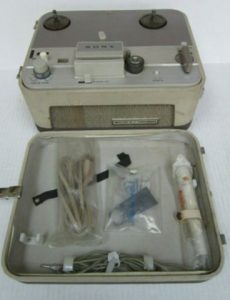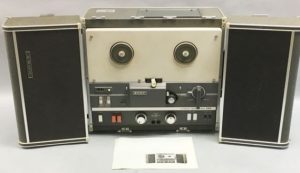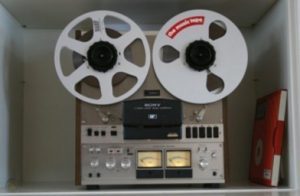Here is my review of most Sony reel to reel tape recorders in two words. Just. Don’t.
One of the earliest North American Sony reel to reels was the TC-102, a compact, mono, 2 speed tube machine. I had one in recently, and other than control cleaning, it needed minimal work to get running.

In the 1960s, Sony did make a ton of reel to reel machines, first tube, including the TC-200 and the TC-500. When these decks came out, they were considered high end, and the specifications and frequency responses were good for the time, 40-18Khz at 7 ½ IPS.

When Sony switched to solid state (transistor) machines, many models were based on very similar transports, using a single lever to switch between play, stop and rewind, with a separate button to go into FF mode. Decks like the TC-250, TC270, TC-630, etc were all relatively similar under the hood, and I’m sure hundreds of thousands were sold worldwide. When the decks were sold, they were relatively reliable and easy to service, however the first series of heads used in the Sony decks were relatively soft, and it wasn’t unusual for a Sony deck to go through several sets of heads if used on a regular basis.
Sony was also known for producing many different models, a great summary of many of them are found here:
http://reel2reeltexas.com/vinListS.html
With many of the 1960s and earlier 1970s decks, Sony made 3 speed decks, with the slow 1 7/8 speed, really only good for speech, as the frequency response was limited to around 8Khz (if you were lucky). Still, lots of people used that speed for background music and for ‘living letters’, which were 3” reels of tape that came with a cardboard package to send to loved ones overseas. Recording tape was as expensive in the 1960s as it is today, so the slow speed was used to conserve tape. By the mid 1970s, almost every tape deck manufacturer dropped the 1 7/8 speed, as decks were primarily used in stereo systems, where fidelity was paramount.
Almost all of these decks were single motor units, where one motor was responsible to drive the tape in all modes of operation. Many manufacturers, including Akai did this for many years.
Around 1973, Sony switched from their soft steel heads to Permalloy heads, which were much longer lasting, most lasting the life of the deck. This improved longevity and reliability significantly.
As Sony progressed with research, they implemented some novel ideas into some models. Some of their auto reverse models had a built in subsonic tone generator that would trigger the auto reverse function, eliminating the need to stick the foil stickers onto the tape the way other manufacturers did. Other models (TC-758, for example) , used a rotating head assembly, where the record and playback heads would rotate 180 degrees, allowing bi-directional recording with only four heads (the other two being the forward and reverse erase heads).

Given the vast size of the Sony corporation, Sony was massive in the consumer market, and developed some reel to reel related technologies that didn’t last the test of time. This included the Elcaset, an oversized cassette tape, ¼” width, running at 3 ¾ IPS, promising the fidelity of reel to reel, in a convenient cassette format. Sony came out with three or four models, as did select other manufacturers (Technics, and I believe Teac), however by the time of its introduction, 1976, the compact cassette format had matured, and the popularity and sound quality of it shut down the Elcast format.
https://en.wikipedia.org/wiki/Elcaset
Later, in 1982. Sony also introduced the DASH digital tape recorder format, recording digitally onto special reel to reel tape. It was another tape format that some studios used for a few years, but did not catch on globally, as the DASH tape was not compatible with any other brand of machine.
https://en.wikipedia.org/wiki/Digital_Audio_Stationary_Head
However, back to Sony reel to reel decks!
Sony developed several decks for the educational market, such as the mono TC-105 single motor deck, and the 3 motor, 3 head TC-650 and 651 that were overbuilt, and designed to be abused by students and staff alike.

While Sony attempted to break into the home studio market, and made at least two four track/four channel machines such as the TC-788-4 and TC-854-4, the market was largely dominated by Teac/Tascam, Fostex and Otari.
Sony bought the American mixer and studio reel to reel company called MCI in 1982, and continued to make studio tape decks into the 1980s.
https://en.wikipedia.org/wiki/Music_Center_Incorporated
Around 1971, Sony started making 3 motor reel to reel decks. While the capstan drive was still belt drive, the reel motors were direct drive. Sony did continue to make single motor decks, with the last one being the 7” TC-399, made from 1978 to 1982.
Pros and cons of Sony reel to reels:
| Pros… |
The biggest problem with Sony reel to reels is that they are not holding up well after 40-60 years of use. While this is a ‘con’ point, the fact that there are so many Sony reel to reels out there, makes them one of the easiest decks to find parts for. Be it the most obscure knob or screw, there’s likely a parts chassis on ebay that you can find on eBay or on your local Craigslist or thrift store to keep your deck going. Many of the single motor Sony decks use relatively simple mechanisms, which are relatively easy to pull apart and to maintain by someone technically inclined.
The single motor Sony decks have electronics that are generally reliable, and with heads in good condition, the fidelity of even the oldest machines is good.
| Cons… |
In my opinion, the list of ‘cons’ of Sony decks far outweigh the positives due to the following reasons:
- Single motor Sony decks commonly lose torque without warning, requiring the motor to be replaced. The problem is, the replacement motors from donor decks can fail as quickly as the motor you’re replacing.
- Sticky white grease. Sony transports use white grease that is often known to harden, especially if the deck hasn’t been used in decades. The pinch roller mechanism and speed selector idler wheel freezes into place, requiring a significant strip-down of the transport to free up the sleeve bearings. Generally this isn’t hard to do, but can consume 2-3 hours of time, resulting in an expensive repair bill.
- Special tools needed to remove tension levers. A number of the high end 10” Sony decks use a special tiny 2 pronged tool to remove the caps that hold the tape tension levers in place. The commonly available C and E clip pliers with the interchangeable 2 prong heads are too small to fit into the Sony decks. One slip of the wrong tool, and you put a permanent scratch into the brushed aluminum. Not good!

